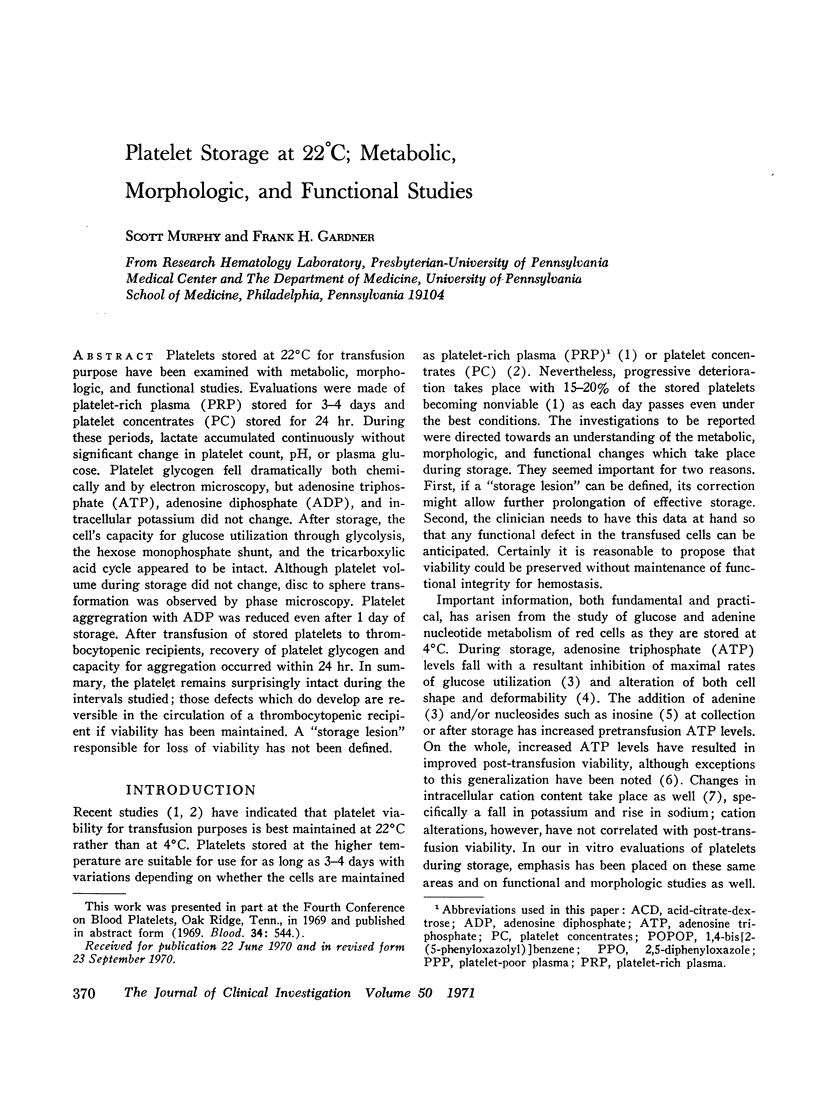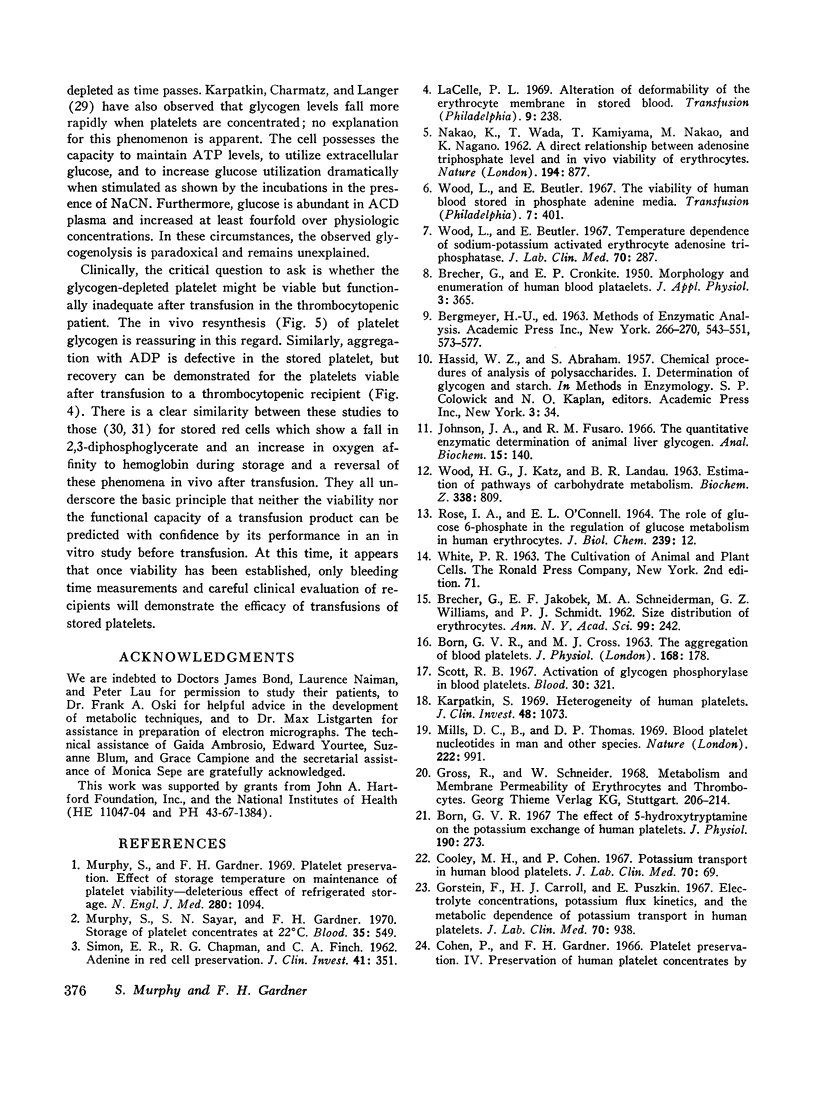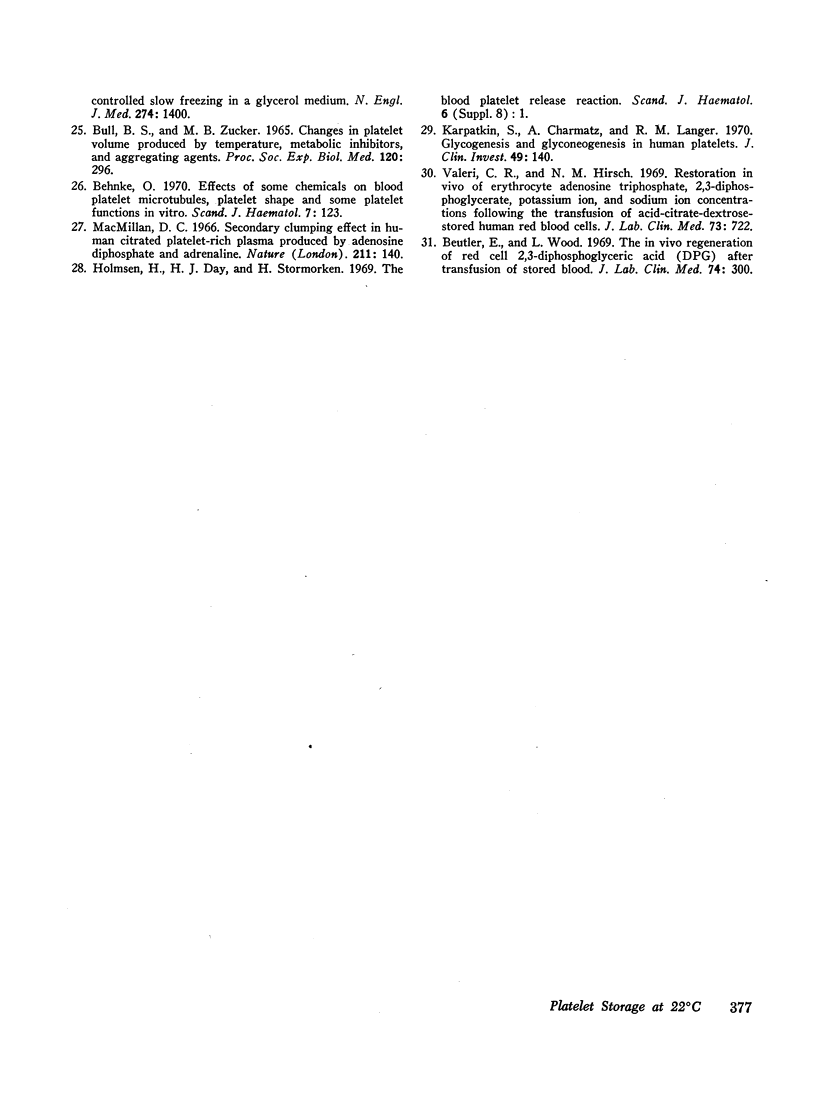Abstract
Platelets stored at 22°C for transfusion purpose have been examined with metabolic, morphologic, and functional studies. Evaluations were made of platelet-rich plasma (PRP) stored for 3-4 days and platelet concentrates (PC) stored for 24 hr. During these periods, lactate accumulated continuously without significant change in platelet count, pH, or plasma glucose. Platelet glycogen fell dramatically both chemically and by electron microscopy, but adenosine triphosphate (ATP), adenosine diphosphate (ADP), and intracellular potassium did not change. After storage, the cell's capacity for glucose utilization through glycolysis, the hexose monophosphate shunt, and the tricarboxylic acid cycle appeared to be intact. Although platelet volume during storage did not change, disc to sphere transformation was observed by phase microscopy. Platelet aggregration with ADP was reduced even after 1 day of storage. After transfusion of stored platelets to thrombocytopenic recipients, recovery of platelet glycogen and capacity for aggregation occurred within 24 hr. In summary, the platelet remains surprisingly intact during the intervals studied; those defects which do develop are reversible in the circulation of a thrombocytopenic recipient if viability has been maintained. A “storage lesion” responsible for loss of viability has not been defined.
Full text
PDF







Selected References
These references are in PubMed. This may not be the complete list of references from this article.
- BORN G. V., CROSS M. J. THE AGGREGATION OF BLOOD PLATELETS. J Physiol. 1963 Aug;168:178–195. doi: 10.1113/jphysiol.1963.sp007185. [DOI] [PMC free article] [PubMed] [Google Scholar]
- BRECHER G., CRONKITE E. P. Morphology and enumeration of human blood platelets. J Appl Physiol. 1950 Dec;3(6):365–377. doi: 10.1152/jappl.1950.3.6.365. [DOI] [PubMed] [Google Scholar]
- BRECHER G., JAKOBEK E. F., SCHNEIDERMAN M. A., WILLIAMS G. Z., SCHMIDT P. J. Size distribution of erythrocytes. Ann N Y Acad Sci. 1962 Jun 29;99:242–261. doi: 10.1111/j.1749-6632.1962.tb45310.x. [DOI] [PubMed] [Google Scholar]
- Behnke O. Effects of some chemicals on blood platelet microtubules, platelet shape and some platelet functions in vitro. Scand J Haematol. 1970;7(2):123–140. doi: 10.1111/j.1600-0609.1970.tb01878.x. [DOI] [PubMed] [Google Scholar]
- Beutler E., Wood L. The in vivo regeneration of red cell 2,3 diphosphoglyceric acid (DPG) after transfusion of stored blood. J Lab Clin Med. 1969 Aug;74(2):300–304. [PubMed] [Google Scholar]
- Born G. V. The effect of 5-hydroxytryptamine on the potassium exchange of human platelets. J Physiol. 1967 May;190(2):273–280. doi: 10.1113/jphysiol.1967.sp008207. [DOI] [PMC free article] [PubMed] [Google Scholar]
- Bull B. S., Zucker M. B. Changes in platelet volume produced by temperature, metabolic inhibitors, and aggregating agents. Proc Soc Exp Biol Med. 1965 Nov;120(2):296–301. doi: 10.3181/00379727-120-30516. [DOI] [PubMed] [Google Scholar]
- Cohen P., Gardner F. H. Platelet preservation. IV. Preservation of human platelet concentrates by controlled slow freezing in a glycerol medium. N Engl J Med. 1966 Jun 23;274(25):1400–1407. doi: 10.1056/NEJM196606232742502. [DOI] [PubMed] [Google Scholar]
- Cooley M. H., Cohen P. Potassium transport in human blood platelets. J Lab Clin Med. 1967 Jul;70(1):69–79. [PubMed] [Google Scholar]
- Gorstein F., Carroll H. J., Puszkin E. Electrolyte concentrations, potassium flux kinetics, and the metabolic dependence of potassium transport in human platelets. J Lab Clin Med. 1967 Dec;70(6):938–950. [PubMed] [Google Scholar]
- Johnson J. A., Fusaro R. M. The quantitative enzymic determination of animal liver glycogen. Anal Biochem. 1966 Apr;15(1):140–149. doi: 10.1016/0003-2697(66)90256-9. [DOI] [PubMed] [Google Scholar]
- Karpatkin S., Charmatz A., Langer R. M. Glycogenesis and glyconeogenesis in human platelets. Incorporation of glucose, pyruvate, and citrate into platelet glycogen; glycogen synthetase and fructose-1,6-diphosphatase activity. J Clin Invest. 1970 Jan;49(1):140–149. doi: 10.1172/JCI106212. [DOI] [PMC free article] [PubMed] [Google Scholar]
- Karpatkin S. Heterogeneity of human platelets. I. Metabolic and kinetic evidence suggestive of young and old platelets. J Clin Invest. 1969 Jun;48(6):1073–1082. doi: 10.1172/JCI106063. [DOI] [PMC free article] [PubMed] [Google Scholar]
- Macmillan D. C. Secondary clumping effect in human citrated platelet-rich plasma produced by adenosine diphosphate and adrenaline. Nature. 1966 Jul 9;211(5045):140–144. doi: 10.1038/211140a0. [DOI] [PubMed] [Google Scholar]
- Mills D. C., Thomas D. P. Blood platelet nucleotides in man and other species. Nature. 1969 Jun 7;222(5197):991–992. doi: 10.1038/222991a0. [DOI] [PubMed] [Google Scholar]
- Murphy S., Gardner F. H. Effect of storage temperature on maintenance of platelet viability--deleterious effect of refrigerated storage. N Engl J Med. 1969 May 15;280(20):1094–1098. doi: 10.1056/NEJM196905152802004. [DOI] [PubMed] [Google Scholar]
- Murphy S., Sayar S. N., Gardner F. H. Storage of platelet concentrates at 22 degrees C. Blood. 1970 Apr;35(4):549–557. [PubMed] [Google Scholar]
- NAKAO K., WADA T., KAMIYAMA T., NAKAO M., NAGANO K. A direct relationship between adenosine triphosphate-level and in vivo viability of erythrocytes. Nature. 1962 Jun 2;194:877–878. doi: 10.1038/194877a0. [DOI] [PubMed] [Google Scholar]
- ROSE I. A., O'CONNELL E. L. THE ROLE OF GLUCOSE 6-PHOSPHATE IN THE REGULATION OF GLUCOSE METABOLISM IN HUMAN ERYTHROCYTES. J Biol Chem. 1964 Jan;239:12–17. [PubMed] [Google Scholar]
- SIMON E. R., CHAPMAN R. G., FINCH C. A. Adenine in red cell preservation. J Clin Invest. 1962 Feb;41:351–359. doi: 10.1172/JCI104489. [DOI] [PMC free article] [PubMed] [Google Scholar]
- Scott R. B. Activation of glycogen phosphorylase in blood platelets. Blood. 1967 Sep;30(3):321–330. [PubMed] [Google Scholar]
- Valeri C. R., Hirsch N. M. Restoration in vivo of erythrocyte adenosine triphosphate, 2,3-diphosphoglycerate, potassium ion, and sodium ion concentrations following the transfusion of acid-citrate-dextrose-stored human red blood cells. J Lab Clin Med. 1969 May;73(5):722–733. [PubMed] [Google Scholar]
- WOOD H. G., KATZ J., LANDAU B. R. ESTIMATION OF PATHWAYS OF CARBOHYDRATE METABOLISM. Biochem Z. 1963;338:809–847. [PubMed] [Google Scholar]
- Wood L., Beutler E. Temperature dependence of sodium-potassium activated erythrocyte adenosine triphosphatase. J Lab Clin Med. 1967 Aug;70(2):287–294. [PubMed] [Google Scholar]
- Wood L., Beutler E. The viability of human blood stored in phosphate adenine media. Transfusion. 1967 Nov-Dec;7(6):401–408. doi: 10.1111/j.1537-2995.1967.tb04875.x. [DOI] [PubMed] [Google Scholar]


